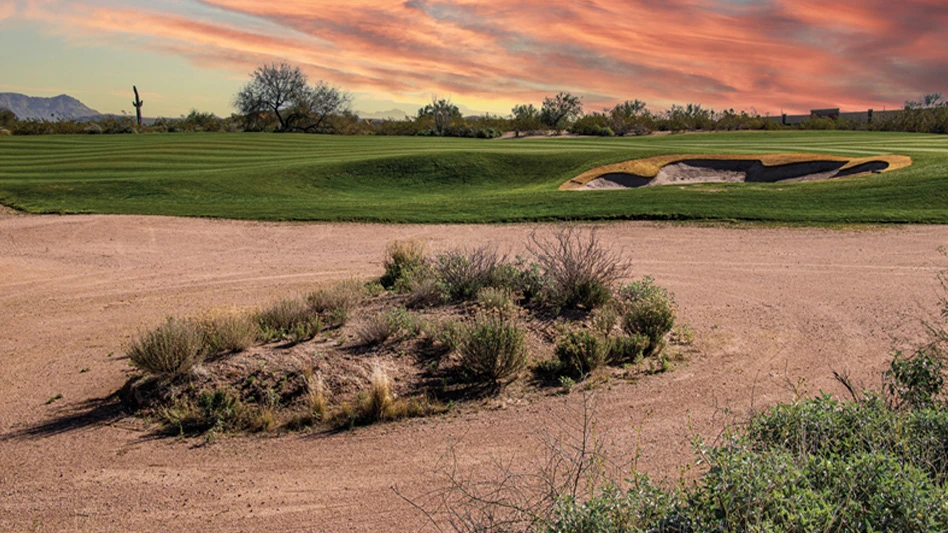
Adobe Stock

Well, I made it through a year in the desert.
Everyone said, “Wait ’til summer!” Well, yep, it was hot. But like any other warm-blooded vertebrate, I acclimated to the change in climate. I acclimated so much that when November rolled around and morning lows dipped below 50, I was coming to work wearing five shirts and wool socks.
Aside from my core temperature, the main differences between cool- and warm-season golf course management were external, and fairly obvious to comprehend on paper prior to my arrival in Arizona — turf types, water management, length of the playing season with seasonal preparations, and the differences in the labor force. Some of these are easy to understand. Others, well, I needed one or two hands-on trials (or tribulations) before seeing what I needed to find my flow.
Water
The first and most important topic in Southwest golf according to anyone and everyone is water management.
While superintendents are constantly striving for better conservation methods and sustainable sourcing, they face a myriad of restrictions, regulations, public sentiment and astronomical costs. Irrigation systems themselves must ensure adequate supply while they operate year-round; therefore, maintenance costs increase while the lifespan decreases when compared to seasonal systems.
Now, contrary to my early conceptions, we do get rain in the desert. Throughout the winter, lighter rain showers will appear, some lingering for a few days. Water use in the winter is most definitely minimal, but still monitored closely for overwatering or dryness. In the summer, monsoon rains are known for their grand entrances and generous deposits of moisture in short periods. If courses are lucky, some of this water can be captured on site and used for irrigation.
Considering the systems I had dealt with in South Dakota, I initially felt that the system we were operating was “overbuilt”. After one summer, the egg on my face was scrambled.
Where I was raised, a course is either located next to a lake or a river, or if free water isn’t above ground, a well is drilled and pumped into a pond on site. Yes, there are some permits and requirements for using certain sources of water, but essentially water sourcing is something that many northern superintendents take for granted. There is less prioritization overall for conservation and sustainable sourcing other than the usual BMPs most of us follow.
While some northern areas deal with dry, arid weather, much of the north receives adequate rainfall — or worse, heavy rains, flooding and increased disease pressure. It almost reaches the point where water becomes more foe than friend.
One thing I’m glad I didn’t have to do in Arizona was winterize the system. Winterization presents a whole new set of challenges in both fall and spring. Timing is essential to beat the first snow, but not blow out too early in case of dry weather. One small pocket of water left behind can shred a 40-foot section of pipe when it freezes, making for a nice surprise on a cool April morning and a new project for your skeleton crew.
The potential problems water management issues in the North are mostly minor and surmountable, and maintenance is less frequent and less costly. Water management in the South is priority No. 1, and the time, effort and costs here show it.

Turf and transitions
Another major difference is the change in seasons … not spring-fall-summer-winter, but from Bermudagrass season to ryegrass season and vice versa. Overall, maintenance practices simply revolve around supporting the health of each variety. For example, topdressing bentgrass in South Dakota is the same as topdressing Bermudagrass in Arizona, and so on. The timing and amounts simply vary based on the season. Southern superintendents are often managing both warm- and cool-season grasses, and the challenges that come with both. Let me boil it down by simply stating that during both overseed and spring transition a balancing act bordering on insanity exists where superintendents are trying to kill one grass while coaxing another to life.
A year on the golf course looks much different. Northern superintendents experience an actual off-season, or at least some downtime between November and April, when activities on the course are minimal at best, and in many cases, covered in snow and ice. Most, or all, of the seasonal crew has gone away and the remaining staff keep busy with inside projects, grinding, tree work and anything else they can while constantly answering the question, “So, what do you do in the winter?”
From a personal health perspective, the winter downtime allows the superintendent to pull back the reins, sleep a little and have somewhat of a normal life compared to the grind of the summer months. It offers time to reset our bodies, both physically and mentally.
On the contrary, warm-season golf is business as usual year-round. When the members and snowbirds head for the hills and our “off-season” begins, there is no ice, snow or sub-zero temperatures to prevent any work. Play subsides just enough to allow maintenance crews to tackle in-house renovations, aerifications and other slightly invasive activities that peak season doesn’t allow for.
Labor force
One aspect I hadn’t really thought about too deeply was what the difference would be from managing a seasonal staff to a full-time staff. One thing I did consider was the language barrier, as I wasn’t fluent in Spanish. A subscription to Babbel proved useful for the first weeks of introductions and learning names and common phrases in the turf world. Beyond that, the iPhone translator mostly assists conversations. I’ve also found that the telenovelas that play in the lunchroom have improved my pronunciation.
The primary difference between northern and southern crews is the seasonality of the North plays a huge role in the type, tenure and experience of available employees. If one isn’t a mechanic, an assistant or a foreman, there isn’t enough consistency in a golf maintenance career. Sure, we get returning seasonal employees, but often face every new season with a team of workers who are new to the facility — or to the job itself. The time in training and orientation alone takes weeks, and just when they’re actually becoming productive, it’s either back to school or regular jobs after just a couple of months’ work.

Explore the December 2024 Issue
Check out more from this issue and find your next story to read.
Latest from Golf Course Industry
- From the publisher’s pen: Conscientious of a bigger role
- Bernhard and Company partners with Laguna Golf Phuket
- Terre Blanche showcases environmental stewardship
- VIDEO: Introducing our December issue
- Bernhard and Company introduces Soil Scout
- Nu-Pipe donates to GCSAA Foundation’s Centennial Campaign
- GCSAA enhances golf course BMP tool
- Melrose leadership programs sending 18 to 2026 GCSAA Conference and Trade Show





